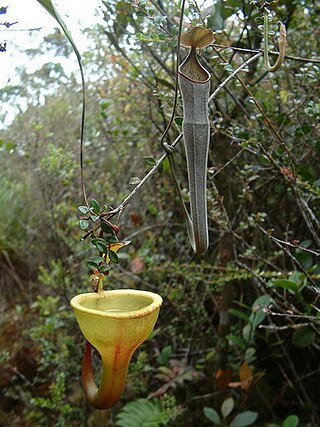| Species | Authority | Year | Image | Distribution | Altitudinal distribution | IUCN conservation status |
|---|
| Nepenthes abalata[4] | Jebb & Cheek[4] | 2013[4] | | Philippines (Culion, Cuyo, Malalison)[4] | 0–20 m[4] | Least Concern |
| Nepenthes abgracilis[5] | Jebb & Cheek[5] | 2013[5] |  | Philippines (Mindanao)[5] | 670 m[5] | Critically Endangered[5] |
| Nepenthes adnata | Tamin & M.Hotta ex Schlauer | 1994 | 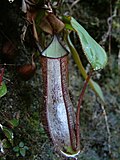 | Sumatra | 600–1,200 m | Endangered |
| Nepenthes aenigma[6] | Nuytemans, W.Suarez & Calaramo[6] | 2016[6] | | Philippines (Luzon)[6] | c. 1,200 m[6] | Data Deficient[6] |
| Nepenthes alata | Blanco | 1837 | 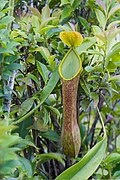 | Philippines (Luzon)[7][nb 1] | 550–? m[nb 1] | Least Concern |
| Nepenthes alba | Ridl. | 1924 |  | Peninsular Malaysia | 1,600–2,187 m | Least Concern |
| Nepenthes albomarginata | T.Lobb ex Lindl. | 1849 |  | Borneo, Peninsular Malaysia, Sumatra
Minor islands: Nias, Penang | 0–1,100 m[nb 2] | Least Concern |
| Nepenthes alfredoi | V.B.Amoroso, N.E.Lagunday, F.P. Coritico & R.D.Colong[9] | 2017[9][10] | | Philippines (Mindanao)[9] | 160–345 m[9] | Critically Endangered[9] |
| Nepenthes alzapan[11] | Jebb & Cheek[11] | 2013[11] |  | Philippines (Luzon)[11] | 1,800 m[11] | Data Deficient |
| Nepenthes ampullaria | Jack | 1835 | 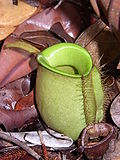 | Borneo, Maluku Islands, New Guinea, Peninsular Malaysia, Singapore, Sumatra, Thailand
Minor islands:[12] Bangka Belitung Islands[13] (Bangka), Bengkalis, Ko Lanta, Ko Tarutao, Langkawi, Mendol, Mentawai Islands (Siberut), Meranti Islands (Padang, Rangsang, Tebing Tinggi), Nias, Penang, Riau Islands (Lingga Islands, Natuna Islands,[14] Riau Archipelago), Rupat | 0–2,100 m | Least Concern |
| Nepenthes andamana[15] | M.Catal.[15] | 2010[15] |  | Thailand[15] | 0–50 m[16] | |
| Nepenthes angasanensis | Maulder, D.Schub., B.R.Salmon & B.Quinn | 1999 | | Sumatra | 2,200–2,800 m | Least Concern |
| Nepenthes appendiculata[17] | Chi.C.Lee, Bourke, Rembold, W.Taylor & S.T.Yeo[17] | 2011[17] | | Borneo[17] | 1,450–1,700 m[17] | Least Concern |
| Nepenthes argentii | Jebb & Cheek | 1997 |  | Philippines (Sibuyan) | 1,400–1,900 m | Vulnerable |
| Nepenthes aristolochioides | Jebb & Cheek | 1997 |  | Sumatra | 1,800–2,500 m | Critically Endangered |
| Nepenthes armin[18] | Jebb & Cheek[18] | 2014[18] | | Philippines (Sibuyan)[18] | 750 m[18] | Least Concern |
| Nepenthes attenboroughii | A.S.Rob., S.McPherson & V.B.Heinrich | 2009 |  | Philippines (Palawan) | 1,450[19]–1,726 m | Critically Endangered |
| Nepenthes barcelonae[20] | Tandang & Cheek[20] | 2015[20] | | Philippines (Luzon)[20] | 1,500–1,700 m[20] | Critically Endangered[20] |
| Nepenthes beccariana | Macfarl. | 1908 |  | Nias, Sumatra?[21] | unknown
(0–<800 m)[22] | Data Deficient[23] |
| Nepenthes bellii | K.Kondo | 1969 |  | Philippines (Dinagat, Mindanao) | 0–800 m | Least Concern |
| Nepenthes benstonei | C.Clarke | 1999 |  | Peninsular Malaysia | 150[24]–1,350 m[25] | Data Deficient[21][23] |
| Nepenthes berbulu | H.L.Tan, G.Lim, Mey, Golos, Wistuba, S.McPherson & A.S.Rob. | 2023[26] | | Peninsular Malaysia[26] | 1,400–2,100 m[26] | Endangered |
| Nepenthes biak[27] | Jebb & Cheek[27] | 2018[27] |  | Schouten Islands (Biak)[27] | sea level[27] | Critically Endangered[27] |
| Nepenthes bicalcarata | Hook.f. | 1873 |  | Borneo | 0–950 m (c. 1,600 m?)[nb 3] | Vulnerable |
| Nepenthes bokorensis | Mey | 2009 | 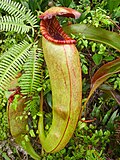 | Cambodia | 800–1,080 m | Endangered[28] |
| Nepenthes bongso | Korth. | 1839 |  | Sumatra | 1,000–2,700 m | Least Concern |
| Nepenthes boschiana | Korth. | 1839 | 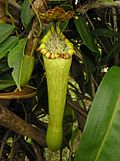 | Borneo | 1,200–1,800 m[nb 4] | Endangered |
| Nepenthes bracteosa | Suran. & Nuanlaong | 2022 | | Thailand | 710–760 m | Critically Endangered |
| Nepenthes burbidgeae | Hook.f. ex Burb. | 1882 |  | Borneo | 1,200–1,800 m[nb 5] | Endangered |
| Nepenthes burkei | Hort.Veitch ex Mast. | 1889 |  | Philippines (Mindoro, Panay?) | 1,100–2,000 m | Conservation Dependent[23] |
| Nepenthes cabanae[31] | Lagunday, N. E. & Amoroso, V. B.[31] | 2019 [31] | | Philippines (Mindanao)[31] | 1,020–1,050 m[31] | Critically Endangered[31] |
| Nepenthes calcicola[32][33] | Gary W.Wilson, S.Venter & Damas[32][33] | 2023[32][33] | | Papua New Guinea[32][33] | 250–270 m[32] | Vulnerable[32] |
| Nepenthes campanulata | Sh.Kurata | 1973 |  | Borneo, Philippines (Palawan?[34]) | 100–300 m[34] | Vulnerable |
| Nepenthes candalaga | Lagunday & V. B. Amoroso | 2022 | | Philippines (Mindanao)[35] | 1,800 – 2,100 m[35] | Critically Endangered |
| Nepenthes ceciliae[36] | Gronem., Coritico, Micheler, Marwinski, Acil & V.B.Amoroso[36] | 2011[36] | 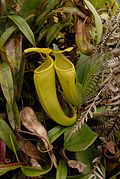 | Philippines (Mindanao)[36] | 1,500–1,880 m[36] | Critically Endangered[37] |
| Nepenthes chang[38] | M.Catal.[38] | 2010[38] |  | Thailand[38] | 300–600 m[38] | |
| Nepenthes chaniana | C.Clarke, Chi.C.Lee & S.McPherson | 2006 |  | Borneo | 1,100–1,800 m | Endangered |
| Nepenthes cid[5] | Jebb & Cheek[5] | 2013[5] |  | Philippines (Mindanao)[5] | 770 m[5] | Critically Endangered[5] |
| Nepenthes clipeata | Danser | 1928 |  | Borneo | 600–800 m | Critically Endangered |
| Nepenthes copelandii | Merr. ex Macfarl. | 1908 |  | Philippines (Mindanao) | 1,100–2,400 m[19] | Least Concern |
| Nepenthes cornuta[39] | Marwinski, Coritico, Wistuba, Micheler, Gronem., Gieray & V.B.Amoroso[39] | 2014[39] |  | Philippines (Mindanao)[39] | ~1,000 m[39] | Vulnerable[39] |
| Nepenthes danseri | Jebb & Cheek | 1997 | | Raja Ampat Islands (Waigeo)[40] | 0–320 m | Vulnerable |
| Nepenthes deaniana | Macfarl. | 1908 |  | Philippines (Palawan) | 1,180–1,296 m | Near Threatened |
| Nepenthes densiflora | Danser | 1940 |  | Sumatra | 1,700–3,200 m | Least Concern |
| Nepenthes diabolica[41] | A.Bianchi, Chi.C.Lee, Golos, Mey, M.Mansur & A.S.Rob.[41] | 2020[41] |  | Sulawesi[41] | 2,200–2,300 m[41] | Critically Endangered[41] |
| Nepenthes diatas | Jebb & Cheek | 1997 |  | Sumatra | 2,400–2,900 m | Least Concern |
| Nepenthes distillatoria | L. | 1753 |  | Sri Lanka | 0–700 m | Vulnerable |
| Nepenthes domei[42] | M.N.Faizal, A.Amin, & A.Latiff[42] | 2020[42] | | Peninsular Malaysia[42] | 850–1,000 m[42] | Vulnerable[42] |
| Nepenthes dubia | Danser | 1928 | 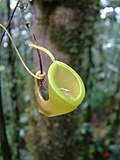 | Sumatra | 1,600–2,700 m | Critically Endangered |
| Nepenthes edwardsiana | H.Low ex Hook.f. | 1859 |  | Borneo | 1,600–2,700 m[nb 6] | Vulnerable |
| Nepenthes ephippiata | Danser | 1928 |  | Borneo | 1,300–2,000 m[nb 7] | Vulnerable |
| Nepenthes epiphytica[44] | A.S.Rob., Nerz & Wistuba[44] | 2011[44] | | Borneo[44] | ~1,000 m[44] | |
| Nepenthes erucoides[45] | A.S. Rob. & S.G. Zamudio[45] | 2019[45] |  | Philippines (Dinagat Islands)[45] | 800–929 m[45] | Critically endangered[45] |
| Nepenthes eustachya | Miq. | 1858 |  | Sumatra | 0–1,600 m | Least Concern |
| Nepenthes extincta[46] | Jebb & Cheek[46] | 2013[46] |  | Philippines (Mindanao)[46] | c. 400 m[46] | Critically Endangered[46] |
| Nepenthes eymae | Sh.Kurata | 1984 |  | Sulawesi | 1,000–2,000 m | Least Concern |
| Nepenthes faizaliana | J.H.Adam & Wilcock | 1991 |  | Borneo | 400–1,600 m | Least Concern |
| Nepenthes flava | Wistuba, Nerz & A.Fleischm. | 2007 |  | Sumatra | 1,800–2,200 m | |
| Nepenthes fractiflexa[47] | Golos, A.S.Rob. & Barer[47] | 2020[47] | | Borneo[47] | 1,400–2,150 m[47] | Near Threatened[47] |
| Nepenthes fusca | Danser | 1928 |  | Borneo | 300[48]–2,500 m | Least Concern |
| Nepenthes gantungensis[49] | S.McPherson, Cervancia, Chi.C.Lee, Jaunzems, Mey & A.S.Rob.[49] | 2010[49] |  | Philippines (Palawan)[49] | 1,600–1,784 m[49] | Vulnerable |
| Nepenthes glabrata | J.R.Turnbull & A.T.Middleton | 1984 | 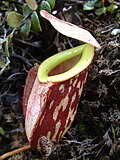 | Sulawesi | 1,600–2,100 m | Least Concern |
| Nepenthes glandulifera | Chi.C.Lee | 2004 | | Borneo | 1,100–1,700 m | |
| Nepenthes graciliflora[7] | Elmer[7] | 1912[7] |  | Philippines (Bohol, Leyte, Luzon, Mindanao, Mindoro, Panay, Samar, Sibuyan)[7] | 300–1,280 m[7] | Least Concern |
| Nepenthes gracilis | Korth. | 1839 |  | Borneo, Cambodia,[50] Peninsular Malaysia, Singapore, Sulawesi, Sumatra, Thailand
Minor islands:[12] Bangka Belitung Islands[13] (Bangka, Belitung[51]), Batu Islands, Bengkalis, Ko Lanta, Ko Tarutao, Labuan,[52] Langkawi, Mendol, Mentawai Islands (Siberut), Meranti Islands (Padang, Rangsang, Tebing Tinggi), Musala, Nias, Penang, Phuket, Riau Islands (Lingga Islands, Natuna Islands,[14] Riau Archipelago), Rupat | 0–1,100 m[nb 8] | Least Concern |
| Nepenthes gracillima | Ridl. | 1908 |  | Peninsular Malaysia | 1,400–2,000 m[24] | Least Concern |
| Nepenthes gymnamphora | Reinw. ex Nees | 1824 |  | Java, Sumatra | 600–2,800 m | Least Concern |
| Nepenthes halmahera[40] | Cheek[40] | 2015[40] | | Maluku Islands (Halmahera)[40] | 10–760 m[40] | Least Concern |
| Nepenthes hamata | J.R.Turnbull & A.T.Middleton | 1984 |  | Sulawesi | 1,400–2,500 m | Least Concern |
| Nepenthes hamiguitanensis[53] | Gronem., Wistuba, V.B.Heinrich, S.McPherson, Mey & V.B.Amoroso[53] | 2010[53] |  | Philippines (Mindanao)[53] | 1,200–1,600 m[53] | Vulnerable[53] |
| Nepenthes harauensis[54] | Hernawati, R.Satria & Chi.C.Lee [54] | 2022 [54] | | Sumatra[54] | 1,100–1,400 m [54] | Unassessed(?)[54] |
| Nepenthes hemsleyana[55] | Macfarl.[55] | 1908[55] |  | Borneo[55] | 0–200 m[56] | Conservation Dependent[57] |
| Nepenthes higaonon[58][59][60] | Lagunday & Amoroso[58][59][60] | 2025[58][59][60] | | Philippines (Mindanao)[58][59][60] | | Critically Endangered[58][59][60] |
| Nepenthes hirsuta | Hook.f. | 1873 | 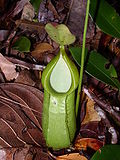 | Borneo | 200–1,100 m[nb 9] | Least Concern |
| Nepenthes hirtella | Nuanlaong & Suran. | 2022 | | Thailand | 348 - 355 m | Critically Endangered |
| Nepenthes hispida | Beck | 1895 |  | Borneo | 100–800 m | Conservation Dependent |
| Nepenthes holdenii[62] | Mey[62] | 2010[62] |  | Cambodia[62] | 600–800 m[62] | Near Threatened[62] |
| Nepenthes hurrelliana | Cheek & A.L.Lamb | 2003 |  | Borneo | 1,300[48]–2,400 m | Least Concern |
| Nepenthes inermis | Danser | 1928 |  | Sumatra | 1,500–2,600 m | Least Concern |
| Nepenthes insignis | Danser | 1928 |  | New Guinea[27] | 0–850 m | Least Concern |
| Nepenthes izumiae | Troy Davis, C.Clarke & Tamin | 2003 |  | Sumatra | 1,700–1,900 m | Least Concern |
| Nepenthes jacquelineae | C.Clarke, Troy Davis & Tamin | 2001 |  | Sumatra | 1,700–2,200 m | Data Deficient[21][23] / Conservation Dependent[63] |
| Nepenthes jamban | Chi.C.Lee, Hernawati & Akhriadi | 2006 |  | Sumatra | 1,800–2,100 m | |
| Nepenthes junghuhnii | sensu Macfarl. in sched. nom.nud. | 1917 | | Sumatra | 1,220 m | Data Deficient[23] |
| Nepenthes justinae[6] | Gronem., Wistuba, Mey & V.B.Amoroso[6] | 2016[6] |  | Philippines (Mindanao)[6] | 1,000–1,620 m[6] | Vulnerable[6] |
| Nepenthes kampalili[64] | Lagunday & V.B. Amoroso[64] | 2024[64] | | Philippines (Mindanao)[64] | 2,200–2,320 m[64] | Critically Endangered[64] |
| Nepenthes kampotiana | Lecomte | 1909 |  | Cambodia, Thailand, Vietnam[65] | 0–600 m[24] | Least Concern |
| Nepenthes kerrii[66] | M.Catal. & Kruetr.[66] | 2010[66] |  | Thailand
Minor islands: Langkawi?[67] | 400–500 m | Least Concern |
| Nepenthes khasiana | Hook.f. | 1873 |  | India | 500–1,500 m | Endangered |
| Nepenthes kitanglad[46] | Jebb & Cheek[46] | 2013[46] |  | Philippines (Mindanao)[46] | 1,800–2,100 m[46] | Critically Endangered[46] |
| Nepenthes klossii | Ridl. | 1916 | 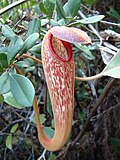 | New Guinea | 930[68]–2,000 m | Endangered |
| Nepenthes kongkandana | M.Catal. & Kruetr.[69] | 2015[69] | 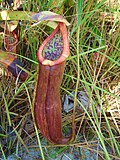 | Thailand | 0–50 m | |
| Nepenthes krabiensis[70] | Nuanlaong, Onsanit, Chusangrach & Suraninpong[70] | 2016[70] | | Thailand[70] | 600–700 m[70] | Critically Endangered[70] |
| Nepenthes lamii | Jebb & Cheek | 1997 |  | New Guinea | 3,200–3,520 m[71] | Least Concern |
| Nepenthes latiffiana[42] | M.N.Faizal, A.Amin & N.Dome[42] | 2020[42] | | Peninsular Malaysia[42] | 1,000-1,100 m[42] | Vulnerable[42] |
| Nepenthes lavicola | Wistuba & Rischer | 1996 | | Sumatra | 2,000–2,600 m | Critically Endangered |
| Nepenthes leonardoi[72] | S.McPherson, Bourke, Cervancia, Jaunzems & A.S.Rob.[72] | 2011[72] | 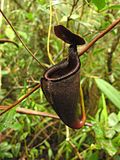 | Philippines (Palawan)[72] | 1,300–1,490 m[72] | Least Concern |
| Nepenthes leyte[46] | Jebb & Cheek[46] | 2013[46] |  | Philippines (Leyte)[46] | 900 m[46] | Critically Endangered[46] |
| Nepenthes limiana[73] | Wistuba, Mey, Golos, S. McPherson & A.S. Rob.[73] | 2023[73] | | Malaysia[73] | 700-2,171 m [73] | Data Deficient[73] |
| Nepenthes lingulata | Chi.C.Lee, Hernawati & Akhriadi | 2006 |  | Sumatra | 1,700–2,100 m | |
| Nepenthes longifolia | Nerz & Wistuba | 1994 |  | Sumatra | 300–1,100 m | Least Concern |
| Nepenthes longiptera | Victoriano | 2021 |  | Sumatra[74] | 750 - 1,600 m | Endangered[74] |
| Nepenthes lowii | Hook.f. | 1859 |  | Borneo | 1,650–2,600 m[nb 10] | Vulnerable |
| Nepenthes maagnawensis[75] | Lagunday & Amoroso[75] | 2025[75] | | Philippines (Mindanao)[76][77] | 2,300–2,700 m[76][77] | Endangered[76][77] |
| Nepenthes macfarlanei | Hemsl. | 1905 |  | Peninsular Malaysia | 900–2,150 m | Least Concern |
| Nepenthes macrophylla | (Marabini) Jebb & Cheek | 1997 |  | Borneo | 2,200–2,642 m[nb 11] | Critically Endangered |
| Nepenthes macrovulgaris | J.R.Turnbull & A.T.Middleton | 1988 |  | Borneo | 300–1,200 m[nb 12] | Least Concern |
| Nepenthes madagascariensis | Poir. | 1797 |  | Madagascar | 0–500 m | Least Concern |
| Nepenthes malayensis[80] | A.Amin, M.N.Faizal & Dome | 2020[80] |  | Peninsular Malaysia (Terengganu) | 800-1,000 m[80] | Critically Endangered[80] |
| Nepenthes malimumuensis[81] | Lagunday, Acma, Cabana, Sabas & V.B. Amoroso | 2017 | | Philippines (Mindanao) | 1,000–1,020 m | Critically Endangered[81] |
| Nepenthes manobo[81] | Lagunday, Acma, Cabana, Sabas & V.B. Amoroso | 2017 | | Philippines (Mindanao) | 1,000–1,020 m | Critically Endangered[81] |
| Nepenthes mantalingajanensis | Nerz & Wistuba | 2007 |  | Philippines (Palawan) | 1,700–2,085 m | Least Concern |
| Nepenthes mapuluensis | J.H.Adam & Wilcock | 1990 |  | Borneo | 7,00–8,00 m | Endangered |
| Nepenthes maryae[82] | Jebb & Cheek[82] | 2016[82] | | Sulawesi[82] | 2,100 m[82] | Vulnerable[82] |
| Nepenthes masoalensis | Schmid-Hollinger | 1977 | | Madagascar | 0–400 m | Endangered |
| Nepenthes maxima | Reinw. ex Nees | 1824 | 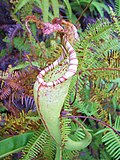 | D'Entrecasteaux Islands,[83] Maluku Islands, New Guinea, Sulawesi
Minor islands: Wowoni?[84] | 40[85]–2,600 m | Least Concern |
| Nepenthes maximoides[86] | King & Cheek[86] | 2020[86] | | Philippines (Luzon, possibly Mt. Banahaw)[86] | | Critically Endangered(possibly Extinct)[86] |
| Nepenthes merrilliana | Macfarl. | 1911 |  | Philippines (Dinagat, Mindanao, Samar[87]) | 0–1,100 m[19] | Vulnerable |
| Nepenthes micramphora | V.B.Heinrich, S.McPherson, Gronem. & V.B.Amoroso | 2009 |  | Philippines (Mindanao) | 1,100–1,635 m | Critically Endangered[37] |
| Nepenthes mikei | B.R.Salmon & Maulder | 1995 |  | Sumatra | 1,100–2,800 m | Vulnerable |
| Nepenthes mindanaoensis | Sh.Kurata | 2001 |  | Philippines (Dinagat, Mindanao) | 0–1,400 m | Least Concern |
| Nepenthes minima[88] | Jebb & Cheek[88] | 2016[88] | | Sulawesi[88] | 1,000–1,700 m[88] | Vulnerable[88] |
| Nepenthes mira | Jebb & Cheek | 1998 |  | Philippines (Palawan) | 1,550–1,605 m | Vulnerable |
| Nepenthes mirabilis | (Lour.) Druce | 1869[89] |  | Australia, Borneo, Cambodia, Caroline Islands (Palau, Yap), China (Guangdong Province, Hainan,[90] Hong Kong, Macau), D'Entrecasteaux Islands, Java, Laos, Louisiade Archipelago, Maluku Islands, Myanmar, New Guinea, Peninsular Malaysia, Philippines (Dinagat, Mindanao), Sulawesi, Sumatra, Thailand, Vietnam
Minor islands:[12] Babi, Bangka Belitung Islands[13] (Bangka), Banyak Islands, Batu Islands, Bengkalis, Enggano, Ko Lanta, Ko Tarutao, Langkawi, Mendol, Mentawai Islands (North Pagai, Siberut, Sipura, South Pagai), Meranti Islands (Padang, Rangsang, Tebing Tinggi), Nias, Penang, Phuket, Riau Islands (Lingga Islands, Riau Archipelago), Rupat, Tawi-Tawi,[46] Wowoni?[84] | 0–1,500 m | Least Concern |
| Nepenthes mollis | Danser | 1928 | | Borneo | ~1,800 m | Data Deficient |
| Nepenthes monticola[71] | A.S.Rob., Wistuba, Nerz, M.Mansur & S.McPherson[71] | 2011[71] | 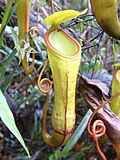 | New Guinea[71] | 1,400–2,620 m[71] | Least Concern |
| Nepenthes muluensis | M.Hotta | 1966 |  | Borneo | 1,700–2,400 m | Least Concern |
| Nepenthes murudensis | Culham ex Jebb & Cheek | 1997 |  | Borneo | 2,000–2,423 m | Least Concern |
| Nepenthes naga | Akhriadi, Hernawati, Primaldhi & M.Hambali | 2009 |  | Sumatra | 1,500–2,000 m | Vulnerable |
| Nepenthes nebularum[91] | G.Mansell & W.Suarez[91] | 2016[91] | | Philippines (Mindanao)[91] | ≤1,800 m[91] | Data Deficient[91] |
| Nepenthes negros[7] | Jebb & Cheek[7] | 2013[7] | | Philippines (Biliran, Negros)[7] | | Critically Endangered[7] |
| Nepenthes neoguineensis | Macfarl. | 1911 |  | D'Entrecasteaux Islands, New Guinea, Raja Ampat Islands (Misool?[68]) | 0–1,400 m | Least Concern |
| Nepenthes nigra[92] | Nerz, Wistuba, Chi.C.Lee, Bourke, U.Zimm. & S.McPherson[92] | 2011[92] | 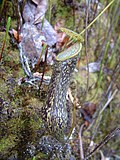 | Sulawesi[92] | 1,500–2,700 m[92] | Least Concern |
| Nepenthes northiana | Hook.f. | 1881 |  | Borneo | 0–500 m | Vulnerable |
| Nepenthes orbiculata[93] | M.Catal. & Kruetr.[93] | 2018[93] | | Thailand[93] | sea level[93] | |
| Nepenthes ovata | Nerz & Wistuba | 1994 |  | Sumatra | 1,700–2,100 m | Least Concern |
| Nepenthes palawanensis[94] | S.McPherson, Cervancia, Chi.C.Lee, Jaunzems, Mey & A.S.Rob.[94] | 2010[94] | 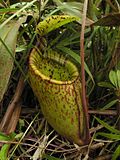 | Philippines (Palawan)[94] | 1,100–1,236 m[94] | Endangered |
| Nepenthes paniculata | Danser | 1928 |  | New Guinea | ~1,460 m | Endangered |
| Nepenthes pantaronensis[39] | Gieray, Gronem., Wistuba, Marwinski, Micheler, Coritico & V.B.Amoroso[39] | 2014[39] |  | Philippines (Mindanao)[39] | "intermediate altitudes"[39] | Least Concern |
| Nepenthes papuana | Danser | 1928 |  | New Guinea | 0–1,300 m | Least Concern |
| Nepenthes parvula[95] | Gary W.Wilson & S.Venter[95] | 2016 | | Australia[95] | | Least Concern |
| Nepenthes peltata | Sh.Kurata | 2008 |  | Philippines (Mindanao) | 865–1,635 m | Critically Endangered[37] |
| Nepenthes pervillei | Blume | 1852 |  | Seychelles | 350–750 m | Least Concern |
| Nepenthes petiolata | Danser | 1928 |  | Philippines (Mindanao) | 1,450–1,900 m | Vulnerable |
| Nepenthes philippinensis | Macfarl. | 1908 | 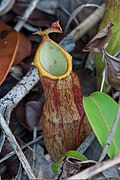 | Philippines (Busuanga, Coron, Culion, Linapacan, Palawan)[19][96] | 0–600 m | Least Concern |
| Nepenthes pilosa | Danser | 1928 |  | Borneo | ~1,600 m | Data Deficient |
| Nepenthes pitopangii | Chi.C.Lee, S.McPherson, Bourke & M.Mansur[97] | 2009[97] |  | Sulawesi | 1,400–1,800 m[67] | Vulnerable |
| Nepenthes platychila | Chi.C.Lee | 2002 | | Borneo | 900–1,400 m | |
| Nepenthes pongoides | Damit, Yusof, Jumian, & A.S.Rob.[98] | 2024[98] | | Borneo[98] | >900 m[98] | Critically endangered[98] |
| Nepenthes pulchra[99] | Gronem., S.McPherson, Coritico, Micheler, Marwinski & V.B.Amoroso[99] | 2011[99] | 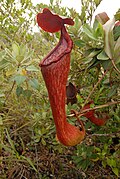 | Philippines (Mindanao)[99] | 1,300–1,800 m[99] | Critically Endangered[37] |
| Nepenthes putaiguneung | Metusala, Farishy, & Jebb[100] | 2020[100] | | Indonesia (Sumatra)[100] | | |
| Nepenthes rafflesiana | Jack | 1835 |  | Borneo, Peninsular Malaysia, Singapore, Sumatra
Minor islands:[12] Bangka Belitung Islands[13] (Bangka), Labuan,[52] Riau Islands (Lingga Islands, Natuna Islands,[14] Riau Archipelago) | 0–1,200 m[nb 13] | Least Concern |
| Nepenthes rajah | Hook.f. | 1859 | 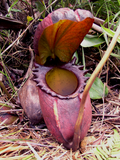 | Borneo | 1,500–2,650 m | Endangered |
| Nepenthes ramispina | Ridl. | 1909 |  | Peninsular Malaysia | 900–2,000 m | Vulnerable |
| Nepenthes ramos[101] | Jebb & Cheek[101] | 2013[101] |  | Philippines (Mindanao)[101]
Minor islands: Camiguin, other neighbouring islands[6] | at least 670–1,400 m[nb 14] | Critically Endangered[101] / Near Threatened[6] |
| Nepenthes reinwardtiana | Miq. | 1852 |  | Borneo, Sumatra
Minor islands:[12] Bangka Belitung Islands[13] (Bangka), Mentawai Islands (Siberut), Nias, Riau Islands (Natuna Islands[14]) | 0–2,200 m | Least Concern |
| Nepenthes rhombicaulis | Sh.Kurata | 1973 | 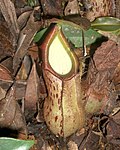 | Sumatra | 1,600–2,000 m | Vulnerable |
| Nepenthes rigidifolia | Akhriadi, Hernawati & Tamin | 2004 |  | Sumatra | 1,000–1,600 m | Critically Endangered |
| Nepenthes robcantleyi | Cheek[102] | 2011[102] |  | Philippines (Mindanao)[102] | ~1,800 m[102] | Critically Endangered[102] |
| Nepenthes rosea[103] | M.Catal. & Kruetr.[103] | 2014[103] |  | Thailand[103] | 450–520 m[103] | |
| Nepenthes rowaniae | F.M.Bailey | 1897 |  | Australia | 0–80 m | Least Concern |
| Nepenthes samar[104] | Jebb & Cheek[104] | 2013[104] | | Philippines (Samar)[104] | "low elevation"[104] | Critically Endangered[104] |
| Nepenthes sanguinea | Lindl. | 1849 | 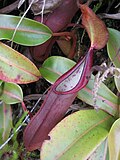 | Peninsular Malaysia, Thailand | 300–1,800 m | Least Concern |
| Nepenthes saranganiensis | Sh.Kurata | 2003 | | Philippines (Mindanao) | 1,800–2,100 m | Endangered[37] |
| Nepenthes sericea[105] | Golos, Wistuba, G.Lim, Mey, S.McPherson & A.S.Rob.[105] | 2023[105] | | Peninsular Malaysia[105] | 1,300–2,183 m[105] | Least Concern[105] |
| Nepenthes sibuyanensis | Nerz | 1998 |  | Philippines (Sibuyan) | 1,250–1,500 m[nb 15] | Vulnerable |
| Nepenthes singalana | Becc. | 1886 |  | Sumatra | 2,000–2,900 m | Least Concern |
| Nepenthes smilesii | Hemsl. | 1895 |  | Cambodia,[108] Laos, Thailand, Vietnam[109] | 0[108]–1,500 m | Least Concern |
| Nepenthes spathulata | Danser | 1935 |  | Sumatra | 1,100–2,900 m | Least Concern |
| Nepenthes spectabilis | Danser | 1928 |  | Sumatra | 1,400–2,200 m | Vulnerable |
| Nepenthes stenophylla | Mast. | 1890 |  | Borneo | 800–2,600 m[nb 16] | Least Concern |
| Nepenthes sumagaya[110] | Cheek[110] | 2014[110] |  | Philippines (Mindanao)[39] | 1,600–2,247 m[39] | Endangered[39] |
| Nepenthes sumatrana | (Miq.) Beck | 1895 |  | Sumatra | 0–800 m | Critically Endangered |
| Nepenthes suratensis[111] | M.Catal.[111] | 2010[111] |  | Thailand[111] | 0–200 m[67] | Critically Endangered |
| Nepenthes surigaoensis | Elmer | 1915 |  | Philippines (Mindanao) | 800–1,200 m[nb 17] | Endangered[37] |
| Nepenthes talaandig[39] | Gronem., Coritico, Wistuba, Micheler, Marwinski, Gieray & V.B.Amoroso[39] | 2014[39] |  | Philippines (Mindanao)[39] | ~1,000 m[39] | Vulnerable[39] |
| Nepenthes talangensis | Nerz & Wistuba | 1994 |  | Sumatra | 1,800–2,500 m | Endangered |
| Nepenthes tboli[18] | Jebb & Cheek[18] | 2014[18] | | Philippines (Mindanao)[18] | 1,463 m[18] | Critically Endangered[18] |
| Nepenthes tenax | C.Clarke & R.Kruger | 2006 | 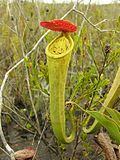 | Australia | 0–80 m | Least Concern |
| Nepenthes tentaculata | Hook.f. | 1873 |  | Borneo, Sulawesi | 400–2,550 m | Least Concern |
| Nepenthes tenuis | Nerz & Wistuba | 1994 |  | Sumatra | 1,000–1,200 m | Endangered |
| Nepenthes thai[28] | Cheek[28] | 2009[28] |  | Thailand[28] | 500–600 m[28] | Endangered[28] |
| Nepenthes thorelii | Lecomte | 1909 | 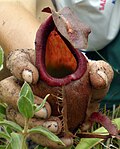 | Vietnam | 10–20 m[113] | Data Deficient |
| Nepenthes tobaica | Danser | 1928 |  | Sumatra | 380–1,800 m[nb 18] | Least Concern |
| Nepenthes tomoriana | Danser | 1928 |  | Sulawesi | 0–500 m | Least Concern |
| Nepenthes treubiana | Warb. | 1891 |  | New Guinea, Raja Ampat Islands (Misool?) | 0–80 m[nb 19] | Least Concern |
| Nepenthes truncata | Macfarl. | 1911 |  | Philippines (Dinagat, Leyte, Mindanao)[19] | 0–1,500 m | Endangered |
| Nepenthes ultra[114] | Jebb & Cheek[114] | 2013[114] | | Philippines (Luzon)[114] | 1.5–40(–400?) m[114][nb 20] | Endangered[114] |
| Nepenthes ulukaliana[105] | A.S.Rob., Wistuba, Mey, Golos, G.Lim & S.McPherson[105] | 2023[105] | | Peninsular Malaysia[105] | 1,200–1,772 m[105] | Near Threatened [105] |
| Nepenthes undulatifolia[115] | Nerz, Wistuba, U.Zimm., Chi.C.Lee, Pirade & Pitopang[115] | 2011[115] | | Sulawesi[115] | ~1,800 m[115] | Data Deficient[115] |
| Nepenthes veitchii | Hook.f. | 1859 |  | Borneo | 0–1,600 m | Least Concern |
| Nepenthes ventricosa | Blanco | 1837 |  | Philippines (Luzon, Panay, Sibuyan)[19] | 1,000–2,000 m | Least Concern |
| Nepenthes vieillardii | Hook.f. | 1873 |  | New Caledonia | 0–850 m | Least Concern |
| Nepenthes villosa | Hook.f. | 1852 |  | Borneo | 1,600–3,240 m[nb 21] | Least Concern |
| Nepenthes viridis[116] | Micheler, Gronem., Wistuba, Marwinski, W.Suarez & V.B.Amoroso[116] | 2013[116] |  | Philippines (Dinagat, Samar)[116]
Minor islands: numerous unspecified islets off Dinagat[116] | | Endangered[37] |
| Nepenthes vogelii | Schuit. & de Vogel | 2002 |  | Borneo | 1,000–1,500 m | Least Concern |
| Nepenthes weda[40] | Cheek[40] | 2015[40] | | Maluku Islands (Halmahera)[40] | 415–1,014 m[40] | Critically Endangered[40] |
| Nepenthes zygon[18] | Jebb & Cheek[18] | 2014[18] | | Philippines (Mindanao)[18] | 1,500–1,875 m[18] | Critically Endangered[18] |
